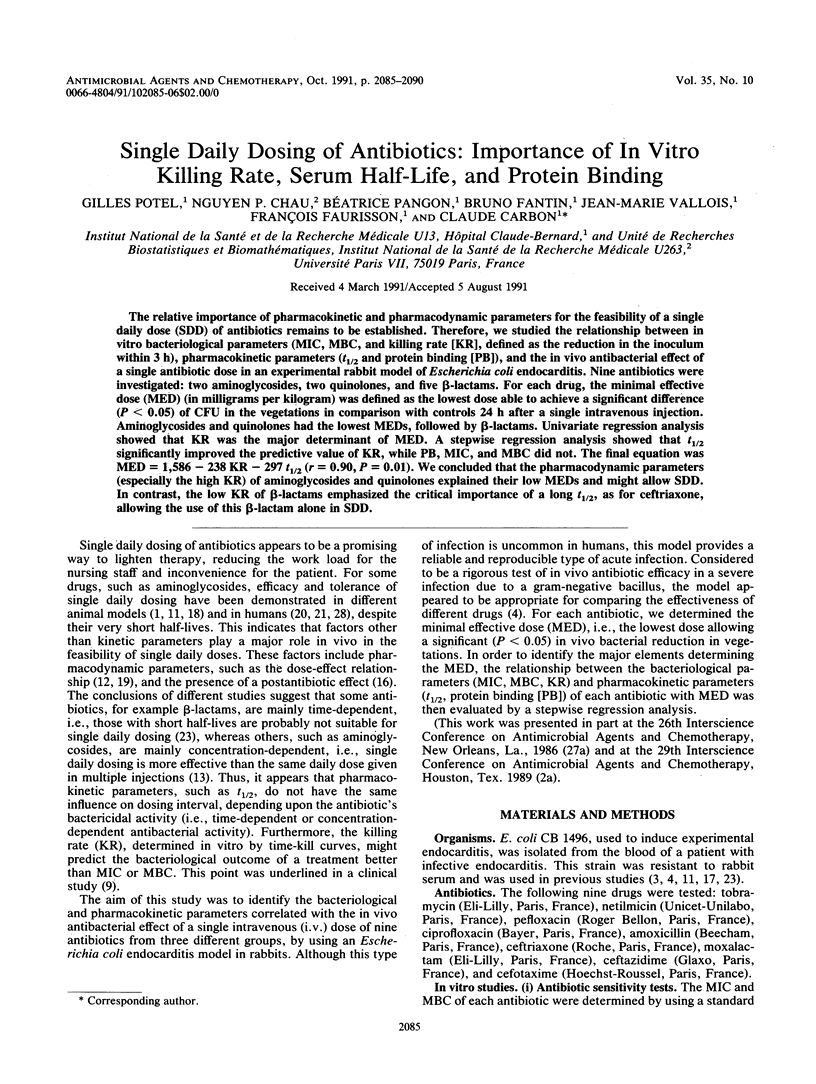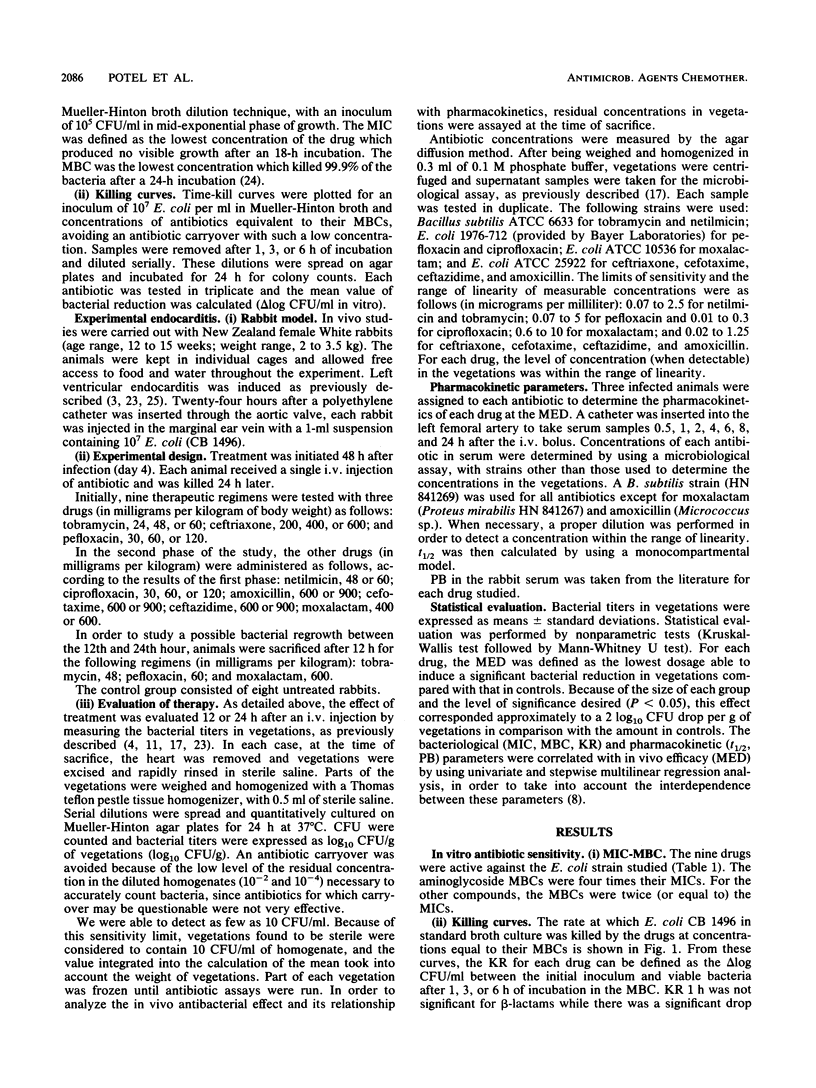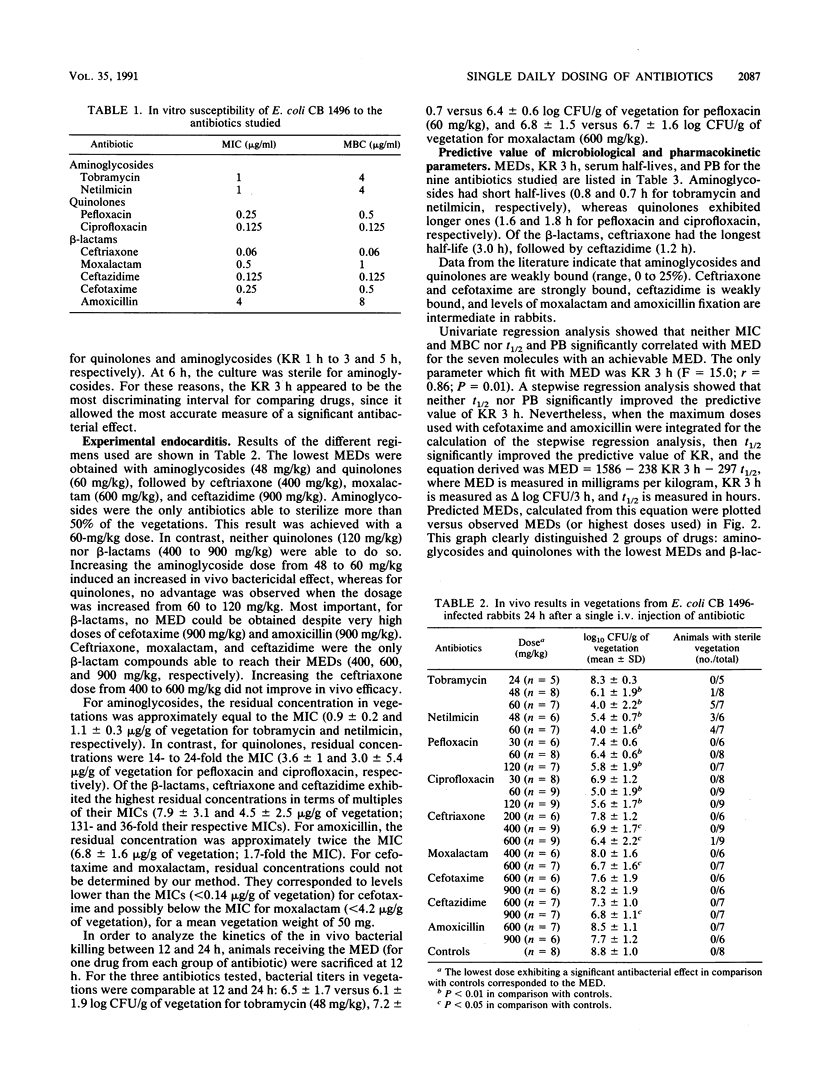Abstract
The relative importance of pharmacokinetic and pharmacodynamic parameters for the feasibility of a single daily dose (SDD) of antibiotics remains to be established. Therefore, we studied the relationship between in vitro bacteriological parameters (MIC, MBC, and killing rate [KR], defined as the reduction in the inoculum within 3 h), pharmacokinetic parameters (t1/2 and protein binding [PB], and in vivo antibacterial effect of a single antibiotic dose in an experimental rabbit model of Escherichia coli endocarditis. Nine antibiotics were investigated: two aminoglycosides, two quinolones, and five beta-lactams. For each drug, the minimal effective dose (MED) (in milligrams per kilogram) was defined as the lowest dose able to achieve a significant difference (P less than 0.05) of CFU in the vegetations in comparison with controls 24 h after a single intravenous injection. Aminoglycosides and quinolones had the lowest MEDs, followed by beta-lactams. Univariate regression analysis showed that KR was the major determinant of MED. A stepwise regression analysis showed that t1/2 significantly improved the predictive value of KR, while PB, MIC, and MBC did not. The final equation was MED = 1,586-238 KR-297 t1/2 (r = 0.90, P = 0.01). We concluded that the pharmacodynamic parameters (especially the high KR) of aminoglycosides and quinolones explained their low MEDs and might allow SDD. In contrast, the low KR of beta-lactams emphasized the critical importance of a long t1/2, as for ceftriaxone, allowing the use of this beta-lactam alone in SDD.
Full text
PDF





Selected References
These references are in PubMed. This may not be the complete list of references from this article.
- Bennett W. M., Plamp C. E., Gilbert D. N., Parker R. A., Porter G. A. The influence of dosage regimen on experimental gentamicin nephrotoxicity: dissociation of peak serum levels from renal failure. J Infect Dis. 1979 Oct;140(4):576–580. doi: 10.1093/infdis/140.4.576. [DOI] [PubMed] [Google Scholar]
- Brion N., Barge J., Godefroy I., Dromer F., Dubois C., Contrepois A., Carbon C. Gentamicin, netilmicin, dibekacin, and amikacin nephrotoxicity and its relationship to tubular reabsorption in rabbits. Antimicrob Agents Chemother. 1984 Feb;25(2):168–172. doi: 10.1128/aac.25.2.168. [DOI] [PMC free article] [PubMed] [Google Scholar]
- Contrepois A., Daldoss C., Pangon B., Garaud J. J., Kecir M., Sarrazin C., Vallois J. M., Carbon C. Pefloxacin in rabbits: protein binding, extravascular diffusion, urinary excretion and bactericidal effect in experimental endocarditis. J Antimicrob Chemother. 1984 Jul;14(1):51–57. doi: 10.1093/jac/14.1.51. [DOI] [PubMed] [Google Scholar]
- Contrepois A., Vallois J. M., Garaud J. J., Pangon B., Mohler J., Meulemans A., Carbon C. Kinetics and bactericidal effect of gentamicin and latamoxef (moxalactam) in experimental Escherichia coli endocarditis. J Antimicrob Chemother. 1986 Feb;17(2):227–237. doi: 10.1093/jac/17.2.227. [DOI] [PubMed] [Google Scholar]
- Cremieux A. C., Maziere B., Vallois J. M., Ottaviani M., Azancot A., Raffoul H., Bouvet A., Pocidalo J. J., Carbon C. Evaluation of antibiotic diffusion into cardiac vegetations by quantitative autoradiography. J Infect Dis. 1989 May;159(5):938–944. doi: 10.1093/infdis/159.5.938. [DOI] [PubMed] [Google Scholar]
- Eng R. H., Cherubin C. E., Pechere J. C., Beam T. R., Jr Treatment failures of cefotaxime and latamoxef in meningitis caused by Enterobacter and Serratia spp. J Antimicrob Chemother. 1987 Dec;20(6):903–911. doi: 10.1093/jac/20.6.903. [DOI] [PubMed] [Google Scholar]
- Eng R. H., Cherubin C., Smith S. M., Buccini F. Examination of gram-negative bacilli from meningitis patients who failed or relapsed on moxalactam therapy. Antimicrob Agents Chemother. 1984 Dec;26(6):850–856. doi: 10.1128/aac.26.6.850. [DOI] [PMC free article] [PubMed] [Google Scholar]
- Fantin B., Pangon B., Potel G., Vallois J. M., Caron F., Bure A., Carbon C. Ceftriaxone-netilmicin combination in single-daily-dose treatment of experimental Escherichia coli endocarditis. Antimicrob Agents Chemother. 1989 May;33(5):767–770. doi: 10.1128/aac.33.5.767. [DOI] [PMC free article] [PubMed] [Google Scholar]
- Frimodt-Møller N., Bentzon M. W., Thomsen V. F. Experimental infection with Streptococcus pneumoniae in mice: correlation of in vitro activity and pharmacokinetic parameters with in vivo effect for 14 cephalosporins. J Infect Dis. 1986 Sep;154(3):511–517. doi: 10.1093/infdis/154.3.511. [DOI] [PubMed] [Google Scholar]
- Gerber A. U., Brugger H. P., Feller C., Stritzko T., Stalder B. Antibiotic therapy of infections due to Pseudomonas aeruginosa in normal and granulocytopenic mice: comparison of murine and human pharmacokinetics. J Infect Dis. 1986 Jan;153(1):90–97. doi: 10.1093/infdis/153.1.90. [DOI] [PubMed] [Google Scholar]
- Gerding D. N., Van Etta L. L., Peterson L. R. Role of serum protein binding and multiple antibiotic doses in the extravascular distribution of ceftizoxime and cefotaxime. Antimicrob Agents Chemother. 1982 Nov;22(5):844–847. doi: 10.1128/aac.22.5.844. [DOI] [PMC free article] [PubMed] [Google Scholar]
- Henning C., Holm S. E. Penetration of 14C-Ro 13-9904 into tissue cage fluid in rabbits. Chemotherapy. 1981;27 (Suppl 1):32–36. doi: 10.1159/000238026. [DOI] [PubMed] [Google Scholar]
- Ingerman M. J., Pitsakis P. G., Rosenberg A. F., Levison M. E. The importance of pharmacodynamics in determining the dosing interval in therapy for experimental pseudomonas endocarditis in the rat. J Infect Dis. 1986 Apr;153(4):707–714. doi: 10.1093/infdis/153.4.707. [DOI] [PubMed] [Google Scholar]
- Joly V., Pangon B., Vallois J. M., Abel L., Brion N., Bure A., Chau N. P., Contrepois A., Carbon C. Value of antibiotic levels in serum and cardiac vegetations for predicting antibacterial effect of ceftriaxone in experimental Escherichia coli endocarditis. Antimicrob Agents Chemother. 1987 Oct;31(10):1632–1639. doi: 10.1128/aac.31.10.1632. [DOI] [PMC free article] [PubMed] [Google Scholar]
- Kapusnik J. E., Hackbarth C. J., Chambers H. F., Carpenter T., Sande M. A. Single, large, daily dosing versus intermittent dosing of tobramycin for treating experimental pseudomonas pneumonia. J Infect Dis. 1988 Jul;158(1):7–12. doi: 10.1093/infdis/158.1.7. [DOI] [PubMed] [Google Scholar]
- Leggett J. E., Fantin B., Ebert S., Totsuka K., Vogelman B., Calame W., Mattie H., Craig W. A. Comparative antibiotic dose-effect relations at several dosing intervals in murine pneumonitis and thigh-infection models. J Infect Dis. 1989 Feb;159(2):281–292. doi: 10.1093/infdis/159.2.281. [DOI] [PubMed] [Google Scholar]
- Maller R., Isaksson B., Nilsson L., Sörén L. A study of amikacin given once versus twice daily in serious infections. J Antimicrob Chemother. 1988 Jul;22(1):75–79. doi: 10.1093/jac/22.1.75. [DOI] [PubMed] [Google Scholar]
- Moore R. D., Lietman P. S., Smith C. R. Clinical response to aminoglycoside therapy: importance of the ratio of peak concentration to minimal inhibitory concentration. J Infect Dis. 1987 Jan;155(1):93–99. doi: 10.1093/infdis/155.1.93. [DOI] [PubMed] [Google Scholar]
- Nichol K. L., Peterson L. R., Fasching C. E., Gerding D. N. Ciprofloxacin penetration into extravascular spaces in a rabbit model. Antimicrob Agents Chemother. 1984 Dec;26(6):935–936. doi: 10.1128/aac.26.6.935. [DOI] [PMC free article] [PubMed] [Google Scholar]
- Pangon B., Joly V., Vallois J. M., Abel L., Buré A., Brion N., Contrepois A., Carbon C. Comparative efficacy of cefotiam, cefmenoxime, and ceftriaxone in experimental endocarditis and correlation with pharmacokinetics and in vitro efficacy. Antimicrob Agents Chemother. 1987 Apr;31(4):518–522. doi: 10.1128/aac.31.4.518. [DOI] [PMC free article] [PubMed] [Google Scholar]
- Pearson R. D., Steigbigel R. T., Davis H. T., Chapman S. W. Method of reliable determination of minimal lethal antibiotic concentrations. Antimicrob Agents Chemother. 1980 Nov;18(5):699–708. doi: 10.1128/aac.18.5.699. [DOI] [PMC free article] [PubMed] [Google Scholar]
- Perlman B. B., Freedman L. R. Experimental endocarditis. II. Staphylococcal infection of the aortic valve following placement of a polyethylene catheter in the left side of the heart. Yale J Biol Med. 1971 Oct;44(2):206–213. [PMC free article] [PubMed] [Google Scholar]
- Potel G., Caillon J., Fantin B., Raza J., Le Gallou F., Lepage J. Y., Le Conte P., Bugnon D., Baron D., Drugeon H. Impact of dosage schedule on the efficacy of gentamicin, tobramycin, or amikacin in an experimental model of Serratia marcescens endocarditis: in vitro-in vivo correlation. Antimicrob Agents Chemother. 1991 Jan;35(1):111–116. doi: 10.1128/aac.35.1.111. [DOI] [PMC free article] [PubMed] [Google Scholar]
- Powell S. H., Thompson W. L., Luthe M. A., Stern R. C., Grossniklaus D. A., Bloxham D. D., Groden D. L., Jacobs M. R., DiScenna A. O., Cash H. A. Once-daily vs. continuous aminoglycoside dosing: efficacy and toxicity in animal and clinical studies of gentamicin, netilmicin, and tobramycin. J Infect Dis. 1983 May;147(5):918–932. doi: 10.1093/infdis/147.5.918. [DOI] [PubMed] [Google Scholar]
- Vogelman B., Gudmundsson S., Leggett J., Turnidge J., Ebert S., Craig W. A. Correlation of antimicrobial pharmacokinetic parameters with therapeutic efficacy in an animal model. J Infect Dis. 1988 Oct;158(4):831–847. doi: 10.1093/infdis/158.4.831. [DOI] [PubMed] [Google Scholar]


